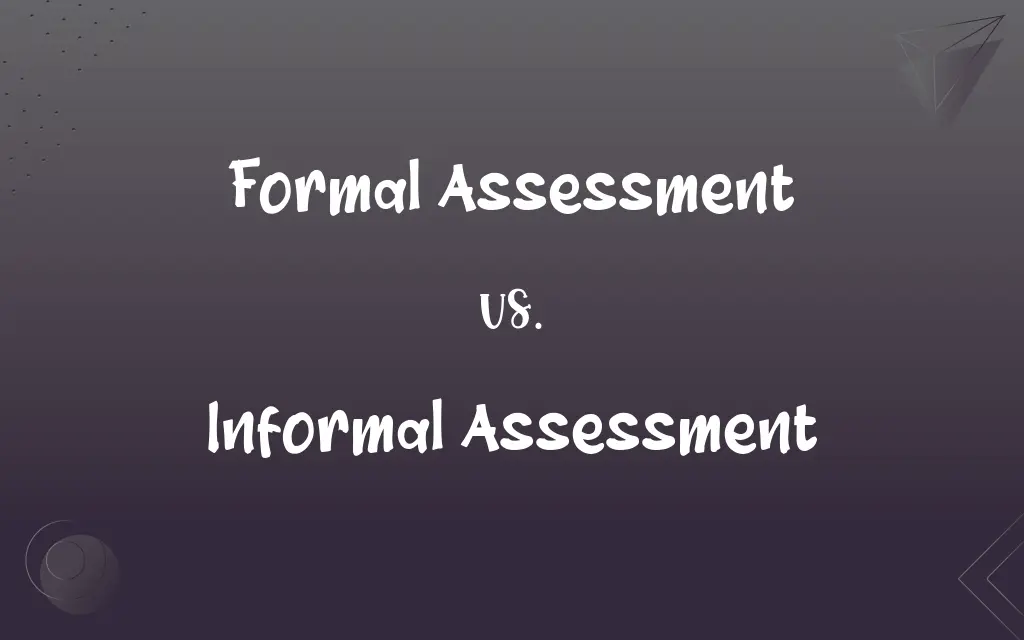Formal Assessment vs. Informal Assessment: What's the Difference?
Edited by Janet White || By Harlon Moss || Updated on October 6, 2023
Formal assessment uses structured tests with set criteria, whereas informal assessment involves unstructured, ongoing observations and feedback.

Key Differences
Formal assessment typically entails standardized tests or exams that are systematically used to evaluate a student's knowledge or skills in a particular area. These tests are structured, have predetermined criteria, and are often graded. On the other hand, informal assessment is more flexible and involves a range of methods, including ongoing observations, verbal discussions, and feedback without fixed criteria.
When educators employ formal assessment, they are usually seeking quantifiable data, often for report cards, certifications, or comparisons among students. The results of formal assessments can influence decisions about student placements, curriculum changes, and resource allocations. In contrast, informal assessment provides qualitative insights into a student's learning process and progress, offering a more holistic view of their strengths, weaknesses, and learning style.
Formal assessment tools, such as standardized tests, are designed to be consistent and impartial. Every student is given the same questions and is assessed under the same conditions, ensuring comparability of results across the board. Informal assessment, conversely, allows for personalized feedback and can adapt to the context, making it more tailored to individual students.
Teachers often use formal assessment to determine if students have met specific learning objectives or to compare students' performances against set benchmarks. These assessments are planned in advance and have a clear scoring system. However, informal assessment can occur spontaneously in the classroom, during activities or discussions, allowing teachers to gain immediate insights and adjust their teaching methods in real-time.
While both formal assessment and informal assessment have their merits and drawbacks, they are often most effective when used together. Formal assessments offer measurable results, while informal assessments provide a deeper understanding of a student's learning journey.
ADVERTISEMENT
Comparison Chart
Nature
Structured and standardized
Unstructured and flexible
Purpose
Quantify knowledge and skills
Gain qualitative insights into learning
Administration
Set conditions and criteria
Varies based on context and situation
Feedback
Often numerical or graded
Usually descriptive, qualitative
Examples
Standardized tests, exams
Observations, discussions, project evaluations
ADVERTISEMENT
Formal Assessment and Informal Assessment Definitions
Formal Assessment
Testing with specific criteria and structured conditions.
End-of-year exams are a type of formal assessment.
Informal Assessment
Ongoing observations to gauge student understanding.
The teacher used an informal assessment by monitoring group discussions.
Formal Assessment
Measurement tools designed for comparisons and grading.
The final project's rubric allowed for a formal assessment of each student's work.
Informal Assessment
Methods offering qualitative feedback on learning.
The art teacher gave informal assessment feedback on students' sketches.
Formal Assessment
An assessment offering quantifiable results.
The math quiz provided a formal assessment of their arithmetic skills.
Informal Assessment
Flexible evaluations adapting to individual student needs.
The science teacher's questions during the lab were part of an informal assessment.
Formal Assessment
Evaluations that are planned and consistent across students.
The statewide reading test is a formal assessment given to all fifth graders.
Informal Assessment
Assessments integrated within learning activities.
The book discussion was an opportunity for informal assessment of comprehension.
Formal Assessment
A standardized method of evaluating student performance.
The SAT is a formal assessment used for college admissions.
Informal Assessment
Evaluations without set conditions or fixed criteria.
Peer reviews in class serve as an informal assessment.
FAQs
What's the primary objective of a formal assessment?
To evaluate student knowledge or skills using standardized tests or criteria.
Why might educators prefer formal assessment at times?
For standardized measurements, comparisons, or official reporting.
When is informal assessment most useful?
To get a holistic view of student progress and adapt teaching methods in real-time.
Can informal assessments be graded?
They can, but they often focus on qualitative feedback rather than grades.
How can educators ensure a balance between both assessment types?
By integrating both into their teaching strategies and understanding their unique benefits.
Can informal assessments influence lesson planning?
Absolutely, they can guide adjustments to teaching strategies based on student feedback.
How does informal assessment differ from formal assessment?
Informal assessment uses ongoing observations and feedback without set criteria, while formal assessment is structured.
Is feedback from informal assessment less valuable?
No, it offers qualitative insights that formal assessments might miss.
Are project evaluations considered formal or informal assessments?
They can be either, depending on the structure and criteria used.
Do informal assessments have a standard format?
No, they're flexible and can vary based on context and objectives.
How frequently are formal assessments conducted?
They are often scheduled, like midterms or finals, whereas informal assessments can be continuous.
How does formal assessment ensure fairness?
By maintaining consistent conditions and criteria for all students.
Does informal assessment allow for personalized feedback?
Yes, it's tailored to individual students and their learning contexts.
What's a common criticism of formal assessments?
They may not capture the full range of a student's abilities or learning style.
Can informal assessment be biased?
Yes, since they're not standardized, personal biases can influence feedback.
Can both assessment types be used together?
Yes, they often complement each other in educational settings.
Can formal assessments be adapted to individual needs?
Typically, they're standardized, but accommodations might be made for special needs.
How do informal assessments support diverse learners?
By allowing for flexibility and accommodating different learning styles.
Why might a teacher use informal assessment daily?
To adjust lessons based on immediate student feedback and understanding.
Can formal assessment capture a student's learning style?
Not always, as it focuses on quantifiable results rather than the learning process.
About Author
Written by
Harlon MossHarlon is a seasoned quality moderator and accomplished content writer for Difference Wiki. An alumnus of the prestigious University of California, he earned his degree in Computer Science. Leveraging his academic background, Harlon brings a meticulous and informed perspective to his work, ensuring content accuracy and excellence.
Edited by
Janet WhiteJanet White has been an esteemed writer and blogger for Difference Wiki. Holding a Master's degree in Science and Medical Journalism from the prestigious Boston University, she has consistently demonstrated her expertise and passion for her field. When she's not immersed in her work, Janet relishes her time exercising, delving into a good book, and cherishing moments with friends and family.






































































